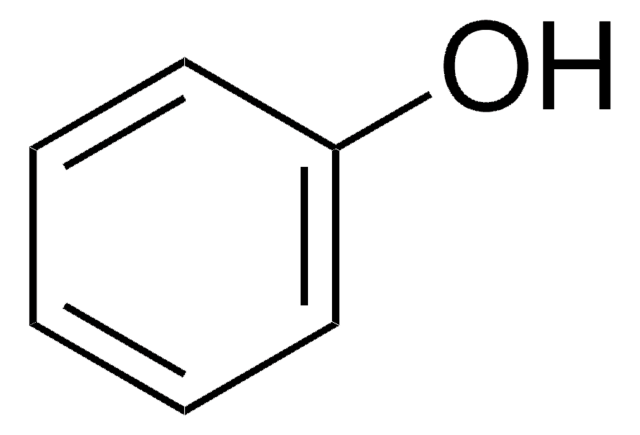24-1520
Phenol stock solution
100 mg/dL, standard
Synonym(s):
Phenol solution
Sign Into View Organizational & Contract Pricing
All Photos(1)
About This Item
Empirical Formula (Hill Notation):
C6H6O
CAS Number:
Molecular Weight:
94.11
Beilstein:
6428463
EC Number:
MDL number:
UNSPSC Code:
12352002
PubChem Substance ID:
grade:
standard
Recommended Products
grade
standard
availability
available only in Japan
concentration
100 mg/dL
SMILES string
Oc1ccccc1
InChI
1S/C6H6O/c7-6-4-2-1-3-5-6/h1-5,7H
InChI key
ISWSIDIOOBJBQZ-UHFFFAOYSA-N
Looking for similar products? Visit Product Comparison Guide
Signal Word
Warning
Hazard Statements
Precautionary Statements
Hazard Classifications
Met. Corr. 1
Storage Class Code
8B - Non-combustible corrosive hazardous materials
WGK
nwg
Flash Point(F)
Not applicable
Flash Point(C)
Not applicable
Personal Protective Equipment
dust mask type N95 (US), Eyeshields, Gloves
Regulatory Information
新产品
Choose from one of the most recent versions:
Already Own This Product?
Find documentation for the products that you have recently purchased in the Document Library.
Nina Sanina et al.
FEBS letters, 587(14), 2260-2265 (2013-06-08)
The present work aimed to compare the effects of different lysophosphatidylethanolamine (LPE) content in lipids derived from Yersinia pseudotuberculosis cells exposed and not exposed to phenol on the conformation of OmpF-like porin of these bacteria. Differential scanning calorimetry and intrinsic
Amani M D Elahwany et al.
Acta biologica Hungarica, 64(1), 106-117 (2013-04-10)
Six isolates with phenol degrading ability were obtained from marine sediments by enrichment procedures and an isolate, AM4, was identified as Alcaligenes sp. by 16S rDNA sequencing. The Plackett-Burman design was applied to estimate the significance of culture medium components
B K Shormanov et al.
Sudebno-meditsinskaia ekspertiza, 56(2), 33-37 (2013-06-27)
The present work was designed to study the specific features of 2-methyl hydroxybezene and 3-methyl hydroxybenzene distribution after intragastric administration of these toxicants to warm-blooded animals (rats). They were detected in the unmetabolized form in the internal organs and blood
Fusheng Jiang et al.
PloS one, 8(2), e58004-e58004 (2013-03-08)
This study was carried out to evaluate the utilization probability of the fibrous root part (FRP) of Bletilla striata, which was usually discarded and harvesting pseudobulb part (PSP). The chemical composition, total phenolic content, DPPH radical scavenging activity, Ferric-reducing antioxidant
Chiung-Fen Chang et al.
Water science and technology : a journal of the International Association on Water Pollution Research, 67(7), 1434-1441 (2013-04-05)
Magnetic TiO2 (MT) composites were prepared and applied to degrading phenol, which is one of the listed priority pollutants. The effects of heat treatment under preparation on the photocatalytic activity of MT composites have been investigated by varying the soaking
Our team of scientists has experience in all areas of research including Life Science, Material Science, Chemical Synthesis, Chromatography, Analytical and many others.
Contact Technical Service

